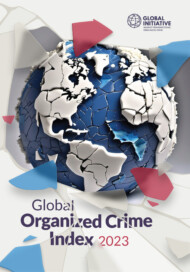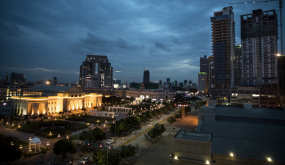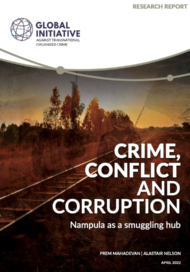Posted on 25 Jun 2025
Arms trafficking in South East Asia has diversified considerably in recent years, moving beyond the legacy weapons from past conflicts that have long saturated the region, and increasingly intersecting with other illicit economies. These changes contributed to an uptick in the region’s arms trafficking score between 2021 and 2023 (4.82 to 5.23 out of 10), according to the Global Organized Crime Index, with the largest increases seen in Laos, Myanmar and Thailand.
This mirrors broader criminality trends observed in the region under the Index, with the overall score rising by a similar margin, from 5.44 to 5.82. Although arms trafficking remains less severe than other illicit economies, such as human trafficking, synthetic drug production and environmental crimes, and has received less attention than the international scam operations that have intensified throughout the region, it is nevertheless a significant criminal economy with far-reaching consequences.
Arms trafficking is also especially dangerous, as it acts as an accelerant for other forms of violence, from armed conflict and gender-based violence to deadly electoral disputes. Trafficked weapons empower criminal actors, including mafia-style groups, youth gangs, extremist groups, insurgent organizations and clan-based militias. Arms trafficking schemes are also vectors for corruption, frequently involving unscrupulous government officials, military and security personnel, politicians and state-backed paramilitary groups.
Persistent and emerging challenges
An examination of recent arms seizures by regional security forces indicates that the region’s trafficking networks now draw on an increasingly diverse range of sources. Porous state armouries, legal civilian markets and skilled craft producers are all major sources of trafficked weapons. A particularly concerning development is the proliferation of converted weapons – blank-firing or air guns modified to fire live ammunition. Such weaponry was used in the 2023 Siam Paragon Mall shooting in Bangkok. And in March 2024, Vietnamese police dismantled a major trafficking network that sold primarily converted airsoft guns. Police in Vietnam’s Mekong Delta region have indicated that converted weapons have become more common in gun-related criminal incidents since 2022. Manufacturing of 3D-printed weapons has also been documented in Myanmar, but they have not yet become widespread in the region.
Illicit firearm markets are also becoming more digitized. Sales, transactions and shipments are increasingly taking place through e-commerce sites, social media platforms, courier services and digital payment systems. In several cases, online platforms have facilitated cross-border arms movements, particularly between Thailand and neighbouring Laos and Vietnam. These platforms also facilitate the transfer of knowledge related to the production, conversion or concealment illicit firearms. The result of all this is that more people can access and participate in illicit markets, exchanging larger volumes of illicit goods with fewer risks.
Developments in regional conflicts are also a major factor. Illicit arms flows in Myanmar have surged since the 2021 coup, whether through battlefield captures by rebel groups, increased artisanal production or trafficking from vulnerable state armouries in Cambodia, India and Thailand. Thai weapons, likely to be trafficked through Myanmar, have been documented among Kuki militias in India’s Manipur state. As violence worsened in Indonesia’s Papua province in 2021, Papuan rebels allegedly sought to purchase weapons in the Philippines’ Mindanao region.
Recent seizures also revealed significant links to other criminal economies. For example, a seizure in Indonesia’s North Maluku in June 2024 revealed that traffickers had bartered endangered Indonesian birds for assault rifles in the Philippines. Raids on well-armed Islamic State-affiliated militants in the Philippines’ Sulu archipelago highlight their involvement in drug trafficking and most likely other smuggling economies across the Sulu Sea. Drug production and scamming activity in Myanmar have also provided armed groups with funding, contributing to their means to procure weapons.
High-level corruption also continues to play a fundamental role in regional arms trafficking. According to the Index, state-embedded actors were the second most prevalent type of criminal actor in South East Asia in 2023, with a score of 6.23 out of 10. In Thailand, a government programme that allows personnel to purchase weapons at a significant discount has repeatedly been abused, including by high-level provincial officials who allegedly sold such weapons to buyers in neighbouring countries. Cambodian military officials and elite political families are said to be linchpins in regional trafficking networks. In the Philippines, former president Rodrigo Duterte exploited his influence to relax gun laws, enabling his family to amass an arsenal of hundreds of weapons that could be used to intimidate rivals and control illicit resources.
Pathways to progress
Despite these challenges, seizure data highlights promising pathways for combating arms trafficking. Notable efforts are being made by countries in the region. In the Philippines, for example, a community-led disarmament programme in conflict-affected parts of Mindanao has resulted in the confiscation of large quantities of weapons. Authorities throughout the region are also improving their ability to detect, investigate and dismantle digitally enabled trafficking networks. Furthermore, bilateral border security cooperation agreements are helping to disrupt cross-border trafficking routes and networks.
However, to be effective, these interventions require a robust understanding of trafficking dynamics down to the local level. Data vividly shows that countries with more permissive reporting conditions provide much stronger evidence of arms trafficking. This involves governments disclosing arms seizures, media outlets reporting on sensitive security issues, and international organizations monitoring long-term conflict and trafficking trends.
A regional perspective on arms trafficking is just as important as localized data. The sources, routes and methods of arms trafficking are often transnational, and regional differences in supply and demand often drive illicit arms flows. Identifying and disrupting these flows require mapping and monitoring of arms trafficking dynamics in each country. Yet few countries in the region have undergone thorough examination, despite raw data being available in many of them. Pulling this data together and tracking changes over time would help the region protect itself against the dangers of arms trafficking and organized crime.
This analysis is part of the GI-TOC’s series of articles delving into the results of the Global Organized Crime Index. The series explores the Index’s findings and their effects on policymaking, anti-organized crime measures and analyses from a thematic or regional perspective.



